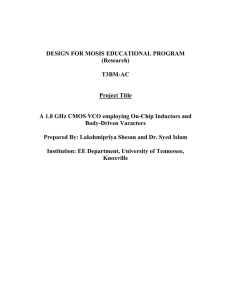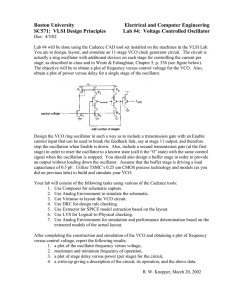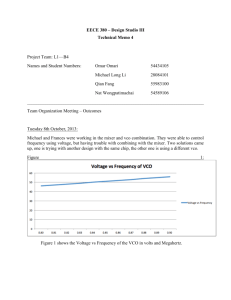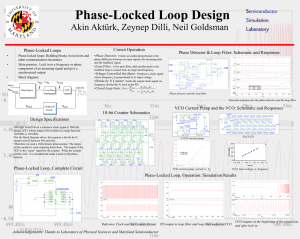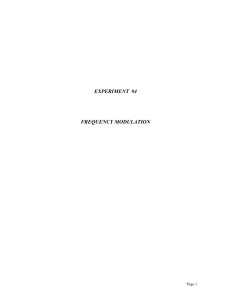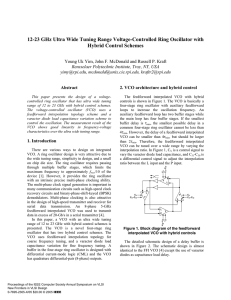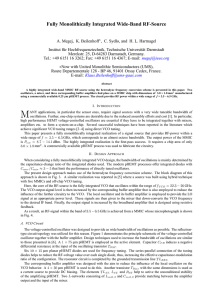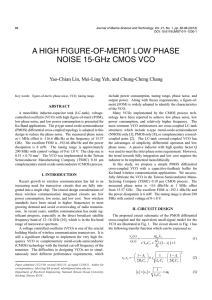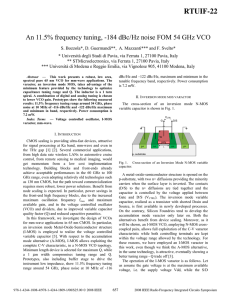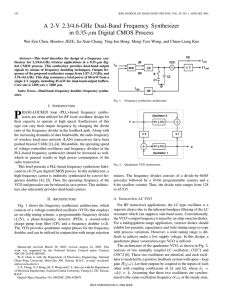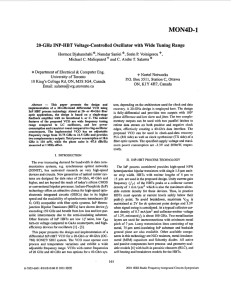ECE545 REPORT 5GHz LNA Design 2.4GHz OSC
advertisement
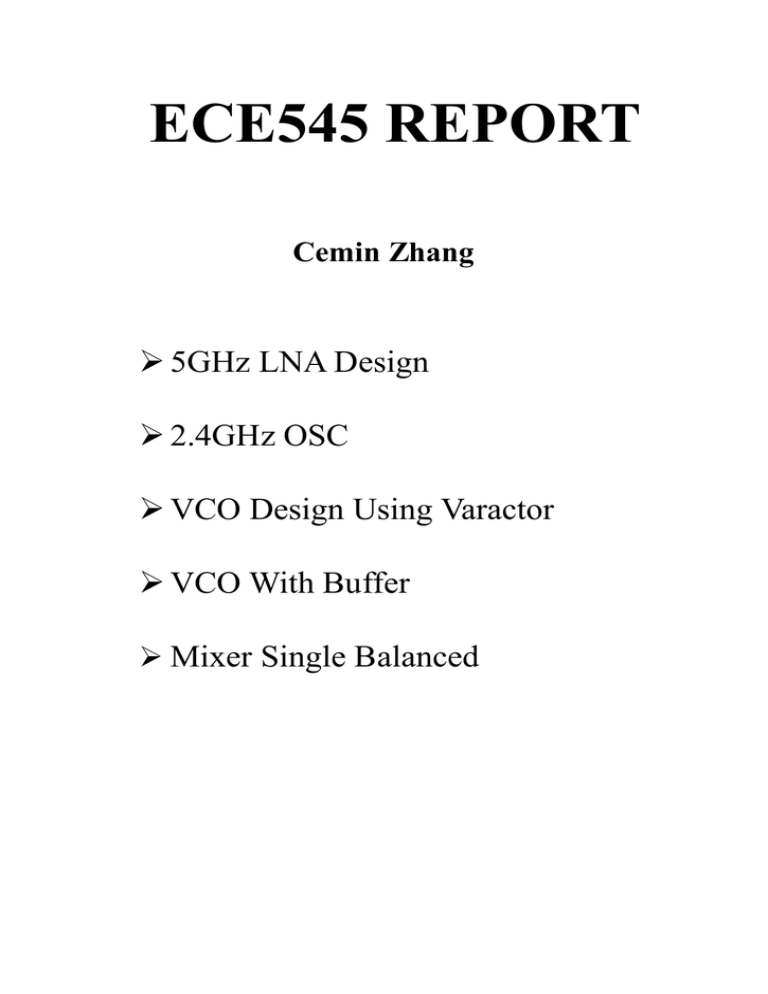
ECE545 REPORT Cemin Zhang 5GHz LNA Design 2.4GHz OSC VCO Design Using Varactor VCO With Buffer Mixer Single Balanced I. 5GHz LNA Design Noise Figure (Simulation): 3.5 3.0 m2 freq=5.000GHz m2=0.904 nf(2) 2.5 2.0 1.5 m2 1.0 0.5 3.0 3.5 4.0 4.5 5.0 5.5 6.0 freq, GHz Comparison of [S] : Simulation(left) and Measurement(right) 20 dB(S(1,2)) dB(S(2,2)) dB(S(1,1)) dB(S(2,1)) 10 0 -10 -20 -30 3.0 3.5 4.0 4.5 5.0 5.5 freq, GHz 6.0 6.5 7.0 6.5 7.0 II. 2.4GHz OSC III. 2 0 1 ts(HB.Vout), V dBm(HB.Vout) 100 -100 -200 -300 0 -1 -2 0 1 2 3 4 5 6 7 0 100 200 harmindex 300 400 500 600 700 800 900 time, psec -40 harmindex -60 pnfm -80 m3 -100 -120 -140 -160 1E2 m3 indep(m3)=1.000E5 m3=-106.732 1E3 1E4 1E5 HB.freq 0 1 2 3 4 5 6 7 1E6 0.0000 Hz 2.408GHz 4.815GHz 7.223GHz 9.631GHz 12.04GHz 14.45GHz 16.85GHz 1E7 noisefreq, Hz Simulation results show the Voltage output in Frequency and Time domain. The OSC frequency is adjusted 2.408GHz, the simulated phase noise is -107dBc@100kHz. III. VCO Design Using Varactor Varactor is the units from MicroMetrics, SMT package. Sample units are at hand. dBm(HB.Vout) m8 0 m8 harmindex=1 m8=9.034 VR=1.000000 m9 m9 harmindex=2 m9=-46.341 VR=11.500000 3 2 ts(HB.Vout), V 100 -100 -200 1 0 -1 -2 -3 -300 0 1 2 3 4 5 6 0.0 7 0.2 0.4 -40 m1 -60 2.4 m12 pnfm -80 2.2 m1 indep(m1)=9.000 m1=2.454E9 2.0 1.0 1.2 (b) (a) 2.6 0.8 time, nsec harmindex HB.freq[1], GHz 0.6 m12 indep(m12)=1.000E4 m12=-94.498 VR=5.500000 -100 -120 -140 1.8 0 2 4 6 8 10 12 14 16 18 20 -160 1E2 1E3 1E4 1E5 HB.VR noisefreq, Hz (c) (d) 1E6 (C) shows the frequency output response as the relationship with the tuning voltage: 1.9GHz – 2.5GHz, 1V-20V; (a) (b) (d) show the output in frequency and time domain and the phase noise performance -95dBc@10kHz 1E7 VCO Measurement Results (a) (b) (c) The plot (a) and (b) show that the frequency range of VCO is from 2.2GHz to 2.33GHz, with tuning voltage from 3V(2.2GHz) to 12V(2.33GHz). Plot (c) shows the detail of the VCO output with tuning voltage at 5V, and the oscillation frequency is 2.265GHz. Output power is low here because: When I increase the bias voltage, some kind of low frequency harmonics will appear. While I keep increasing the bias, the transistor will be burned. I will try to figure out how to solve this problem. VI. VCO With Buffer Buffer Performance is similar with Part III design, but have good isolation between load and VCO, and has adjustable output power. V. Single Balanced Mixer Design RF: 2.45 GHz (-10dBm) LO: 2.35 GHz IF: 100 MHz m4 -7 0 m5 indep(m5)=4.000 m5=-44.412 -10 -9 RF_LO_Iso ConvGain -8 m4 indep(m4)=4.000 m4=-7.524 -10 -11 -20 -30 m5 -40 -12 -13 -50 -6 -4 -2 0 2 4 6 8 10 -6 -4 -2 Pow er_LO 0 2 4 6 8 Pow er_LO Conversion Gain VS. PLO : ILmin @ PLO=4dBm Isolation (RF-LO port) VS LO Power m1 -7 ConvGain -8 -9 -10 -26.5 -26.6 -26.7 -11 2.0E9 -26.4 RF_LO_Iso m1 indep(m1)=2.360E9 m1=-7.018 -26.8 2.2E9 2.4E9 2.6E9 2.8E9 3.0E9 Sig Conversion Gain VS. RF : ILmin @ RF=2.36GHz 2.0E9 2.2E9 2.4E9 2.6E9 2.8E9 3.0E9 Sig Isolation (RF-LO port) VS. RF Freqency 10 10 m1 Power_RF=3.000 m1=-4.659 Pif_dBm Pif_ext 5 0 m1 m2 -5 -10 m2 Power_RF=3.000 m2=-5.628 -15 -20 -10 -5 0 5 10 15 Power_RF P1dB point when PRF=3dBm, so RF power input to the Mixer should be < 3dBm Mixer Measurement Results Based on the simulation results, I choose the value below during the measurement: RF: 2.45GHz, -10dBm LO: 2.35GHz, 4dBm (a) (c) (b) (d) Figure (a) shows IF signal, with the RF and LO leakage at IF output port. The conversion gain is -7.7dB, which is very close to the simulation result(-7.56dB) Figure (b) shows the detail of IF output signal Figure (c) shows LO and RF leakage at IF port, the LO at IF port is -36dBm, which means the LO to IF isolation is -40dB Figure (d) shows the IF harmonics, the 2nd harmonics (200MHz) is -50dBm

